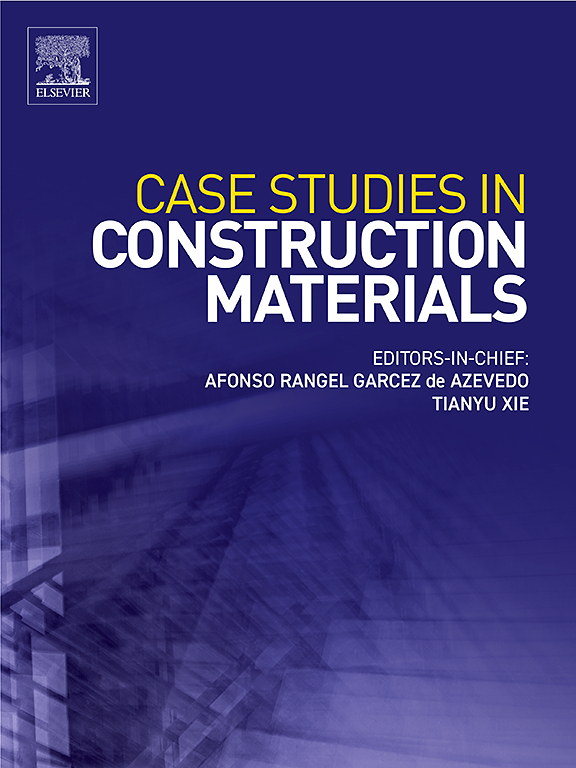钢渣增强水泥稳定再生骨料抗硫酸盐性能:优化配合比设计及机理研究
IF 6.6
2区 工程技术
Q1 CONSTRUCTION & BUILDING TECHNOLOGY
引用次数: 0
摘要
水泥稳定再生骨料(CSR)作为一种可持续材料在路面施工中引起了广泛的关注。但在硫酸盐侵蚀下,其性能明显恶化。本研究旨在通过加入钢渣骨料(SSA)和采用d -最优配合比设计(DOD)方法优化配合比设计,提高CSR的抗硫酸盐性能。通过无侧限抗压强度和热收缩试验确定了再生骨料(RA)和SSA的掺量范围。采用DOD模型确定了水泥稳定RA与SSA (CSRS)的最佳配比。采用x射线衍射(XRD)、傅里叶变换红外光谱(FTIR)和扫描电镜-能谱(SEM-EDS)分析了SSA增强CSR抗硫酸盐性能的机理。结果表明,RA和SSA对天然骨料(NA)的替代率应分别控制在60% %和36% %。DOD模型确定的最佳CSRS混合比例为40 % NA, 48.5% % RA和17 % SSA。实验验证表明,所有的绝对相对偏差(ARD)都在5 %以下,验证了DOD模型的准确性。SSA中活性矿物(主要是C2S和C3S)参与水化反应,形成额外的C-S-H凝胶,细化了界面过渡区(ITZ),将其宽度减小到27 μm,限制了硫酸盐的进入途径,减轻了硫酸盐对CSRS的攻击。这些发现为优化类似混合料设计和促进RA在路面基层应用中的应用提供了有价值的见解。本文章由计算机程序翻译,如有差异,请以英文原文为准。
Enhancing sulfate resistance of cement-stabilized recycled aggregate with steel slag: Optimized mix design and mechanistic insights
Cement-stabilized recycled aggregate (CSR) has garnered considerable attention as a sustainable material in pavement construction. However, its performance significantly deteriorates under sulfate attack. This study aims to enhance the sulfate resistance of CSR by incorporating steel slag aggregate (SSA) and optimizing the mix design using the D-optimal mixture design (DOD) method. Dosage ranges for recycled aggregate (RA) and SSA were determined by unconfined compressive strength (UCS) and thermal shrinkage tests. The optimal mix proportion of cement-stabilized RA and SSA (CSRS) was established using the DOD model. X-ray diffraction (XRD), Fourier transform infrared spectroscopy (FTIR), and scanning electron microscopy-energy dispersive spectroscopy (SEM–EDS) were employed to investigate the mechanism by which SSA enhances the sulfate resistance of CSR. The results indicated that the replacement ratios of RA and SSA for natural aggregate (NA) should be limited to 60 % and 36 %, respectively. The optimal CSRS mix proportion determined by the DOD model comprised 40 % NA, 48.5 % RA, and 17 % SSA. Experimental validation demonstrated that all absolute relative deviations (ARD) were below 5 %, verifying the accuracy of the DOD model. The reactive minerals in SSA, primarily C2S and C3S, participated in hydration reactions, leading to the formation of additional C-S-H gel, which refined the interfacial transition zone (ITZ), reduced its width to 27 μm, limited sulfate ingress pathways, and mitigated sulfate attack on CSRS. These findings provide valuable insights for optimizing similar mixture designs and promoting RA utilization in pavement base applications.
求助全文
通过发布文献求助,成功后即可免费获取论文全文。
去求助
来源期刊

Case Studies in Construction Materials
Multiple-
CiteScore
7.60
自引率
19.40%
发文量
842
审稿时长
63 days
期刊介绍:
Case Studies in Construction Materials provides a forum for the rapid publication of short, structured Case Studies on construction materials. In addition, the journal also publishes related Short Communications, Full length research article and Comprehensive review papers (by invitation).
The journal will provide an essential compendium of case studies for practicing engineers, designers, researchers and other practitioners who are interested in all aspects construction materials. The journal will publish new and novel case studies, but will also provide a forum for the publication of high quality descriptions of classic construction material problems and solutions.
 求助内容:
求助内容: 应助结果提醒方式:
应助结果提醒方式:


